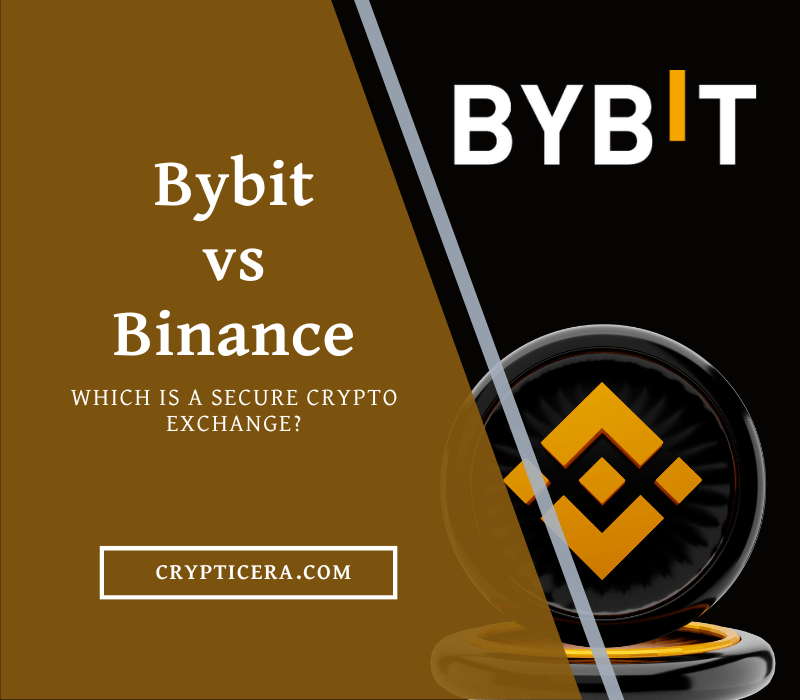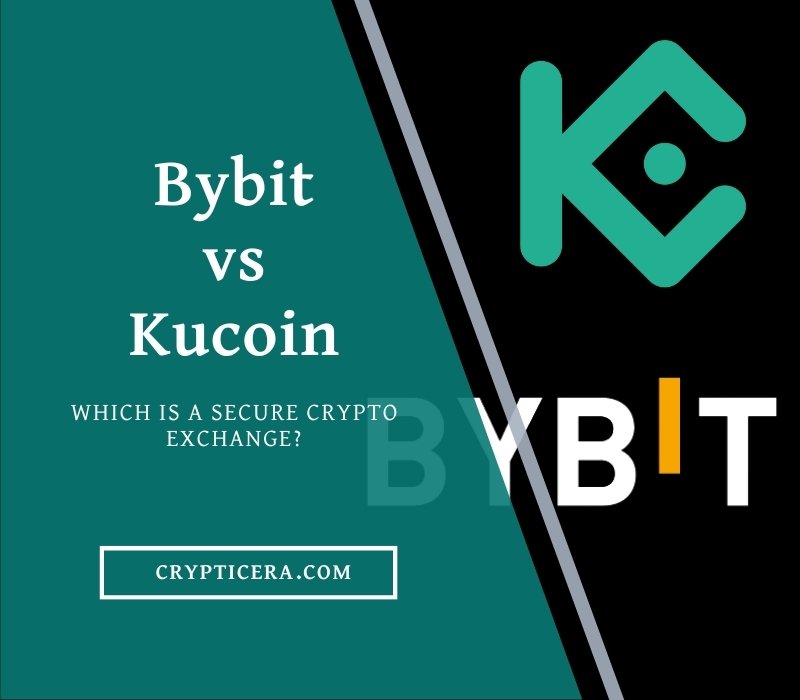One of the most popular and trusted brands of hardware wallets is Trezor. It was launched in 2014 by SatoshiLabs, a Czech company that pioneered the concept of hardware wallets.
Trezor has two models available in the market: Trezor Model One and Trezor Model T. Both models are designed to provide high-quality security and user experience for cryptocurrency users.
But which one should you choose? What are the differences and similarities between them? How do they compare in terms of features, pros and cons? In this article, we will answer these questions and help you decide which Trezor model (Trezor Model One vs Model T) is better for you.
Key Differences: (Which Should You Buy?)
- The Trezor Model T has a USB-C port and an SD-card slot, while the Trezor Model One has a USB-A port. The USB-C port can offer faster data transfer and compatibility with more devices, while the SD-card slot can be used for future features such as encrypted storage or offline transactions.
- The Trezor Model T has a touchscreen that lets you enter your PIN and passphrase directly on the device, while the Model One has two buttons that require you to enter your PIN and passphrase on your Trezor suite App.
- The Trezor Model T supports more cryptocurrencies than the Trezor Model One.
- Model T has a larger screen, more memory, and a faster processor than the Trezor Model One. This can offer a better user experience, faster performance, and more room for future updates.
- The Trezor Model T comes with a magnetic dock that allows you to attach your device to any metal surface for easy access and storage. The Trezor Model One does not come with a magnetic dock.
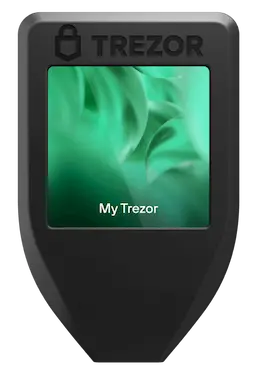
We Recommend buying Trezor Model T over Model One due to more security measures, more supported coins, and a touchscreen display. If These are not your requirements, Model One is also a good option.
Trezor Model One vs Model T: Comparison
| Feature | Trezor Model One | Trezor Model T |
|---|---|---|
| Price | $59-$69 | $215 |
| Screen | OLED display with two buttons | Color touchscreen |
| Cryptocurrencies supported | 1289 | 1456 |
| Screen Size | 60 x 30 x 6mm | 64 x 39 x 10mm |
| Weight | 12 g | 22 g |
| Display | 128×64px | 240×240px |
| Battery | No (Need to Plug-in) | No (Need to Plug-in) |
| Central processing unit (CPU) | ARM Cortex-M3 embedded-arm processor @ 120Mhz | ARM Cortex-M4 embedded-arm processor @ 168Mhz |
| Operating system | Requires download and installation | Preloaded |
| Connection | micro-USB | USB Type-C |
| Recovery | Standard seed Backup | Advanced Shamir Backup |
| Password manager | ✔ | ✔ |
| FIDO2 authentication | ✘ ✘ | ✔ |
| Cold storage | ✔ | ✔ |
| Native support for ERC20 tokens | ✔ | ✔ |
| PIN code protection | ✔ | ✔ |
| Multi-sig Support | ✔ | ✔ |
| Open-source firmware | ✔ | ✔ |
| NFT Support | ✔ | ✔ |
| MicroSD card slot | ✘ ✘ | ✔ |
| Trezor Suite app | ✔ | ✔ |
Related: Trezor Model One Review
Trezor Model One vs Model T: Design and Build Quality
➤ Size: The Trezor Model One is more compact than the Model T, with dimensions of 60 x 30 x 6 mm compared to 64 x 39 x 10 mm. The Model One can be easily carried in a pocket or a wallet, while the Model T is a bit more bulky.
➤ Display: The Trezor Model T has a touchscreen display that takes up most of the front side of the device, while the Trezor Model One has two buttons. The touchscreen makes it easier to enter and navigate, as well as improves security during the recovery seed process. The non-touchscreen display needs two physical buttons to operate and confirm actions.
➤ Weight: The Trezor Model T is heavier than the Model One, with a weight of 22 g versus 12 g. The weight difference is not much, but it may affect the portability and comfort of holding the device.
➤ Feel: The Trezor Model T has a smooth and sleek feel, with curved edges and a shiny finish. The Trezor Model One has a more rough and textured feel, with sharp edges and a dull finish. The feel of the device may depend on personal preference and comfort.
➤ Build quality: Both devices are made of sturdy plastic and have a solid build quality. However, the Trezor Model T has a more premium and modern look, while the Trezor Model One has a more simple and classic look.
➤ Connectivity: The Trezor Model T can connect via USB Type-C, while the Trezor Model One only provides a micro-USB connection. The USB Type-C allows for faster data transfer and compatibility with newer devices. The USB connection requires a cable and may limit the mobility of the device.
Read: Ledger vs Trezor Comparison
Winner: Trezor model T is large in size, has a touchscreen display, and has Type-c connectivity for fast data transfer.
Trezor Model One vs Model T: Supported Cryptocurrencies
The Trezor Model T can store more types of digital assets than the Trezor Model One. The Trezor Model T has over 1456 supported coins and tokens, while the Trezor Model One has over 1289 cryptocurrencies.
Some of the popular coins supported by both models are Cardano (ADA), Ripple (XRP), Monero (XMR), Eos (EOS), Tezos (XTZ), and Binance Chain (BNB).
Trezor hardware wallets can handle NFTs that are based on the Ethereum network and follow the EIP-721 standard.
However, Trezor Suite does not offer the feature to show and control NFTs. You will need to use a third-party interface like MetaMask to link your Trezor and see your NFTs on a gallery platform like Opensea.
Winner: Model T Supports more coins and tokens than Model One.
Trezor Model One vs Model T: Security Measures
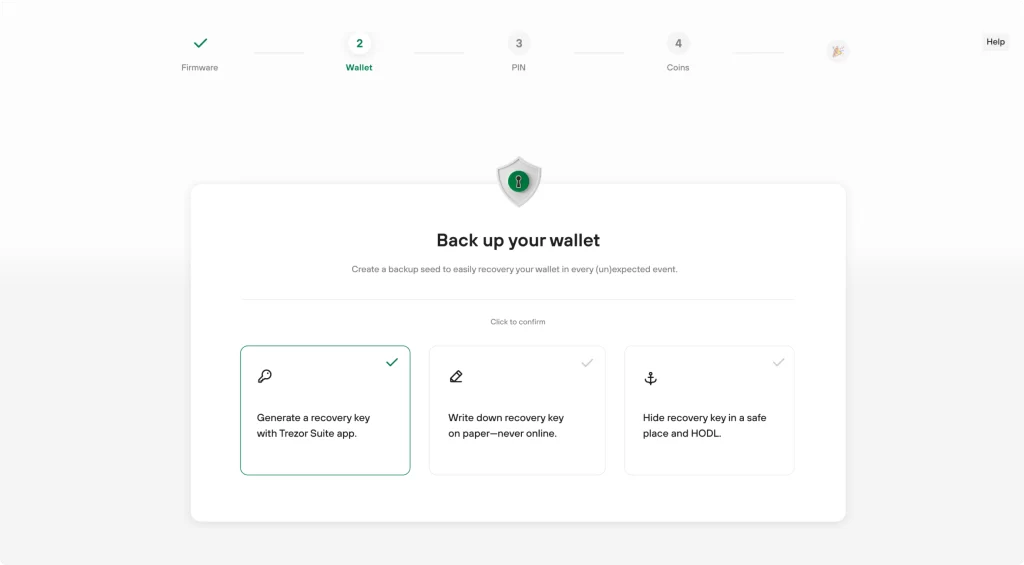
It is one of the secure crypto hardware wallets. The Trezor Model T supports Shamir Backup, a feature that lets you split your recovery seed into multiple parts and store them separately.
This can offer more security and flexibility in case you lose or damage your device or backup. The Trezor Model One does not support Shamir Backup.
Both Trezor Wallets use encrypted storage to keep your private keys and other personal information safe from being exposed. Your private keys never leave your device and are only accessible by entering your PIN or passphrase.
The firmware is open-source and can be verified by anyone. You can also update your firmware regularly to get the latest security patches and features.
Trezor model one and T both support multi-sig wallet creation and transaction signing. The devices are CE and RoHS certified.
Trezor Model T uses an ARM Cortex-M4 embedded-arm processor @ 168Mhz, whereas Model One uses an ARM Cortex-M3 embedded-arm processor @ 120Mhz.
Winner: Trezor Model T offers better security than Model One due to the advanced Shamir backup feature and updated CPU.
Trezor Model One vs Model T: Software Wallet Integration
Both Trezor devices support 50+ software wallets. Some of the popular software wallets that are supported by the Trezor Models are Metamask, Exodus, Coinomi, Trust Wallet, Atomic Wallet, and Edge.
The addition of these software allows Trezor users to participate in staking, mining, airdrops, and ICOs. Trezor suite alone does not allow these features.
They enable users to buy, sell, swap, and earn crypto directly within the app. You can also use your software wallet to interact with various decentralized applications (DApps) and protocols on the blockchain.

Winner: Tie, Both models support Software wallet integration.
Trezor Model One vs Model T: Price
The Trezor Model T costs $219, while the Trezor Model One costs $69.
The Trezor Model T has a higher price because it has more features and capabilities than the Trezor Model One, such as a touchscreen, a USB-C port, an SD-card slot, Shamir Backup, and more supported cryptocurrencies.
Winner: Model T is more affordable than Model One
Trezor Model One vs Model T: User Experience
The Model T is easier to use than the Model One because it has a touchscreen and menus that are simple to follow.
The Model One makes you use two buttons to move around, which can be annoying for some users. Both devices are simple to set up and work with different software wallets and platforms.
The Trezor suite app is the official software for your Trezor device that you can use on your desktop or web browser. It helps you to securely send and receive coins, buy and sell cryptocurrencies quickly, keep and use your crypto in different ways, and access various features to keep your privacy and identity safe.
The Trezor Suite app works with over 1318 coins and tokens that you can use with your Trezor device, whether it is the Model One or the Model T. You can also check your balance on your phone with the Trezor Suite lite app, which does not need you to connect your Trezor device.
Trezor Model One vs Model T: How to set up?
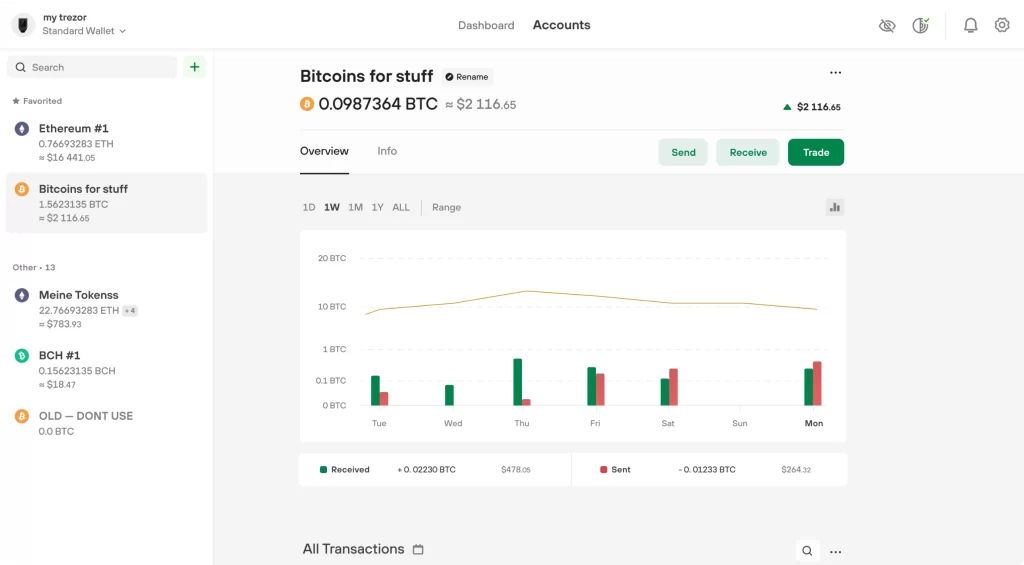
To set up your device, you will need a computer with an internet connection, a USB cable, and the Trezor suite app. Here are the steps to follow:
- Plug your Trezor device into your computer using the USB cable. Make sure you push until you hear a slight click.
- Open your web browser and visit https://trezor.io/start/. Select your Trezor model from the options.
- Download and install the Trezor bridge, which is software that helps your device to talk to the Trezor suite app.
- Refresh the page and follow the instructions on the screen. You will need to install the firmware on your device, which is the software that runs on it.
- After installing the firmware, you will need to make a backup of your recovery seed, which is a list of words that represents your private keys. Write down the words on a paper card and keep them in a secure place. Do not take a photo or store it online.
- You will also need to set up a PIN code, which is a number that protects your device from unauthorized access. Choose a PIN that is hard to guess and remember it well.
- You can also turn on additional security features, such as passphrase protection or Shamir backup, depending on your device model and preference.
- Once you have finished the setup, you can access the Trezor suite app on your desktop or web browser.
- You can now send and receive coins, exchange cryptocurrencies, organize your wallets and accounts, and use various security and privacy features with your Trezor device.
Final Verdict: Winner (Which Should You Choose?)
So, what’s the verdict? Which Trezor wallet should you get to keep your crypto safe and sound?
Well, it really depends on what you’re looking for and how much you’re willing to spend. Both Trezor Model One and Model T have a lot in common, but they also have some key differences that set them apart.
At the end of the day, the choice between Trezor Model One and Model T is up to you. Both wallets are trustworthy, secure, and user-friendly, and will help you protect your digital assets.
FAQs
What is the difference between Trezor T and Trezor One?
Trezor T and Trezor One are both excellent crypto hardware wallets, but they have some key differences. Trezor T boasts a bigger touchscreen, a more powerful processor, a USB-C connector, an SD card slot, and more crypto support than Trezor One.
Is Trezor Model T more secure than Trezor One?
Both Trezor T and Trezor One are very secure devices that have CE and RoHS certifications. However, Trezor T has some extra security features, such as Shamir Backup, which lets users divide their recovery seed into multiple pieces and a touchscreen that displays the real transaction data on the device.
Is it safe to buy 2nd hand Trezor Model?
Buying a used Trezor Model is risky, as it could have been altered or hacked by the previous owner. The only way to guarantee the genuineness and safety of a Trezor device is to purchase it directly from the official website or from an authorized reseller.
Related:
- Ledger vs BitBox02 vs Trezor
- Trezor vs Ellipal Titan
- SafePal vs Trezor vs ELLIPAL vs Ledger
- Safepal S1 vs Trezor One
- Best Hardware Wallet for XRP
- Best Cold Wallets for Crypto
